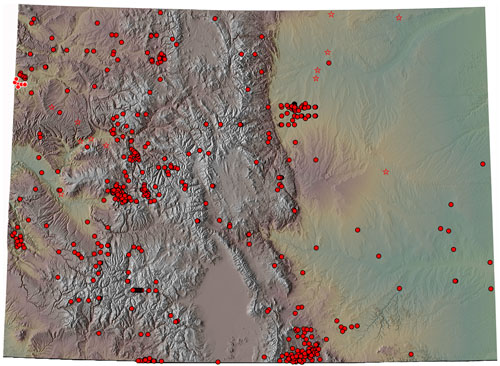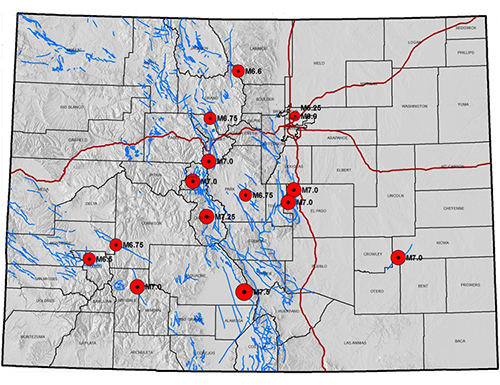Earthquake
Earthquakes are the vibrations or shaking created when large blocks of the earth’s crust move against one another. The break between these blocks is a “fault.” Most earthquakes in the earth’s crust occur from movement on faults. Less frequently, some earthquakes are caused by volcanic or magmatic activity (Colorado Natural Hazards Mitigation Plan).
Magnitude and intensity are terms used to describe seismic activity. Magnitude (M) is a measure of the total energy released. Each earthquake has one magnitude. Intensity (I) is used to describe the effects of the earthquake at a particular place. Intensity differs throughout the area. The Richter Scale is commonly used to measure magnitude, and the Modified Mercalli Intensity Scale (MMI) measures intensity.
The most intense shaking experienced during earthquakes generally occurs near the rupturing fault and decreases with distance away from the fault. In a single earthquake, however, the shaking at one site can easily be 10 times stronger than at another site, even when their distance from the ruptured fault is the same.
Many earthquakes in Colorado occur naturally; however, they can also be caused by human actions. Humans may trigger earthquakes through different types of activities including oil and gas extraction, reservoir impoundment, fluid injection, or mining.
Although many of Colorado’s past earthquakes have occurred in mountainous regions, some have been located in the western valleys and plateau region or east of the mountains. Thousands of faults have been mapped in Colorado, but scientists think only about 90 of these have been active in the past 1.6 million years. Portions of the state have clusters of faults, such as near the Denver metro region, central mountains, and the southwestern and northwestern part of the state. Seismic activity is largely absent in Northeast Colorado.
The Sangre de Cristo Fault, which lies at the base of the Sangre de Cristo Mountains along the eastern edge of the San Luis Valley, and the Sawatch Fault, which runs along the eastern margin of the Sawatch Range, are two of the most prominent potentially active faults in Colorado. Not all of Colorado’s potentially active faults are in the mountains. For example, the Cheraw Fault, which is in the Great Plains in southeast Colorado, appears to have had movement during the recent geologic past. Some faults, such as the Derby Fault near Commerce City, cannot be seen at the earth’s surface.
Even though the seismic hazard risk in Colorado is relatively low to moderate compared to other states like California, it is likely that future damaging earthquakes will occur in Colorado. More than 500 earthquake tremors of magnitude 2.5 or higher have been recorded in the state since 1867. More earthquakes of magnitude 2.5 to 3.0 probably occurred during that time but were not recorded because of the sparse distribution of population and limited instrumental coverage in much of the state (for comparison, more than 20,500 similar-sized events have been recorded in California during the same time period.)

The largest known earthquake in Colorado occurred on November 7, 1882, and had an estimated magnitude of 6.5. The location of this earthquake, which has been the subject of much debate and controversy over the years, appears to have been in the northern Front Range west of Fort Collins. The most economically damaging earthquake in Colorado’s history occurred on August 9, 1967, in the Denver metropolitan area. This 5.3 magnitude earthquake caused more than $1 million in damages in Denver and the northern suburbs (Colorado Natural Hazards Mitigation Plan). This earthquake is believed to have been induced by the deep injection of liquid waste into a borehole at Rocky Mountain Arsenal.
More recently, a magnitude 5.3 earthquake occurred on August 23, 2011, causing moderate damage near Segundo and Valdez in southern Colorado. In recent years, seismic activity appears to be on an upward trend in Colorado, with 30 seismic events recorded in 2013 and 44 events recorded in 2014.
Earthquake events have the potential to trigger avalanches, landslides, soil hazards (liquefaction, uneven ground settling), and flooding caused by the failure of dams, levees or other impoundment structures. Additionally, broken natural gas lines and other pipelines may cause hazardous material releases and often result in structural fires following the event.
Colorado Geological Survey
The Colorado Geological Survey is the primary agency for maintaining Colorado earthquake hazard information.
- The CGS Earthquake page is a one-stop location for finding more information on Colorado earthquakes.
- The Earthquake Reference Collection is a listing of over 500 earthquakes and faulting events that have taken place in Colorado.
- The Colorado Earthquake and Late Cenozoic Fault and Fold Map Server is an online map viewer that indicates where fault lines and folds can be found in Colorado.
Unites States Geological Survey
The United States Geological Survey (USGS) is the primary federal government agency for providing information on earthquakes.
- The USGS National Seismic Hazards Map is a national standard for identifying earthquake hazard zones.
- USGS also maintains a site dedicated to Colorado Earthquake Information.
National Earthquake Hazards Reduction Program
The National Earthquake Hazards Reduction Program (NEHRP) is the federal government’s coordinated long-term nationwide program to reduce risks to life and property in the U.S. resulting from earthquakes.
Federal Emergency Management Agency (FEMA)
FEMA maintains a resource website that provides useful information regarding earthquakes.
Additionally, FEMA's Hazus is available for estimating vulnerability due to earthquakes. Hazus is a nationally applicable standardized methodology that contains models for estimating potential losses from earthquakes, floods, and hurricanes. Hazus uses Geographic Information Systems (GIS) technology to estimate physical, economic, and social impacts of disasters. It is a loss estimation tool, but is not predictive. It graphically illustrates the limits of identified high-risk locations due to earthquakes, hurricanes, and floods. Users can then visualize the spatial relationships between populations and other more permanently fixed geographic assets or resources for the specific hazard being modeled, a crucial function in the pre-disaster planning process.
The Colorado Geological Survey utilized Hazus to determine the potential locations and impacts of various magnitude earthquakes on faults across Colorado. Hazus summary reports on potential losses may be downloaded for both statewide scenarios as well as for individual counties.

of earthquakes in Colorado.
The CGS Interactive Hazus Events Map details epicenters of possible future seismic events based on Maximum Credible Earthquakes (MCE) that have been assigned to specific faults by various entities. Each of the event locations have been analyzed using FEMA Hazus software and correspond to statewide reports on potential loss and damage.The CGS Interactive Hazus Events Map details epicenters of possible future seismic events based on Maximum Credible Earthquakes (MCE) that have been assigned to specific faults by various entities. Each of the event locations have been analyzed using FEMA Hazus software and correspond to statewide reports on potential loss and damage.
Colorado Earthquake Hazard Mitigation Council
The Colorado Earthquake Hazard Mitigation Council (CEHMC) is a multi-disciplinary organization that is interested in developing a better understanding of earthquake hazards in Colorado. The group meets monthly and has been in existence in various forms for more than three decades.
